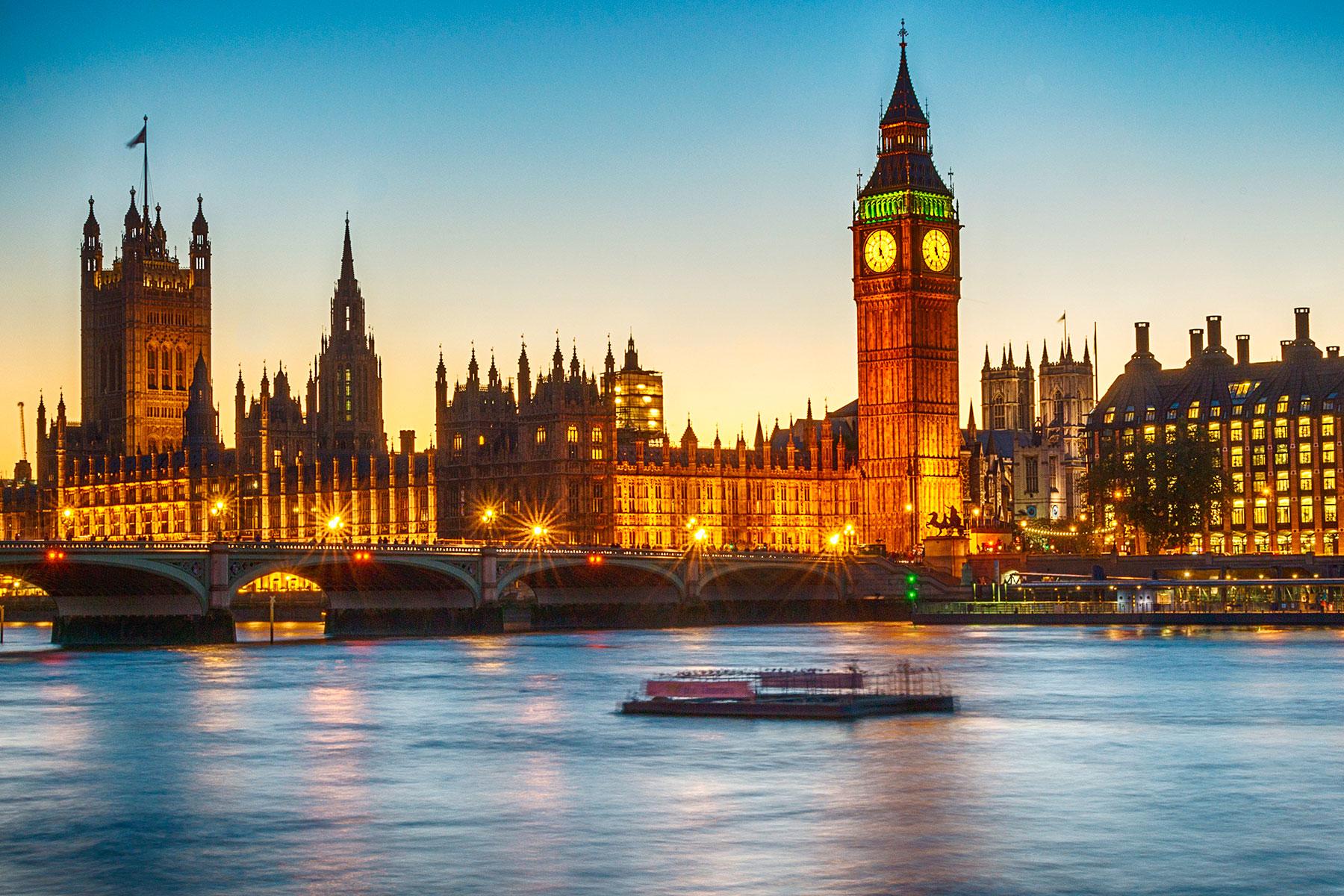From Stonehenge and Bath to the Cornish Coast, from bustling cities like Manchester and Liverpool and London, England is the home of Shakespeare, the Beatles, and afternoon tea.
An island nation with an array of historic intrigue, beautiful landscape, cosmopolitan cities, and quirky eccentricities, England may not be big, but boy is it packed full of things to do. And sure, while it may not look like much of a distance from Land’s End in Cornwall to the border of Scotland, given the number of scenic spots, country houses, steam trains, afternoon teas, and Druid monuments to take in between the two, you’ve got to have a handy guide to help you experience the most quintessentially English vacation possible. Check off the 26 things to do on this list and you’ll feel as English as fish and chips.
Top Picks for You
Explore the Sights of London
The majority of visitors land in London so where better to start than in the capital. While all corners of the city have their charms, start centrally–where many of the major sights are located. Must-visit attractions—as opposed to London’s best under-the-radar attractions—include the National Portrait Gallery, the British Museum, Natural History Museum, V&A Museum, and Houses of Parliament (among others). When you’re done with cultural institutions, take to the South Bank for some al fresco adventuring. An arts center on the bank of the river Thames, the collection of the Royal Festival Hall, the BFI, Hayward Gallery, and the South Bank Centre keeps the waterside promenade thronging with buzzy, creative energy. In London, don’t be afraid to be a cliché–which means get that picture in a red phone box, make a dumb face next to the Buckingham Palace guards, and definitely pose on the Beatles’ Abbey Road crossing. Just remember: Standing on the left of the escalators is one cliché to avoid.
Need a place to stay while you are in town? We’ve got London hotel recommendations.
INSIDER TIPPlenty of events, exhibitions, and galleries are free, and the Southbank is an especially great place to take children.
Related: 25 Ultimate Things to Do in London and 12 Things NOT to Do in London
See Stonehenge at Sunrise or Sunset
A wonder of the world, the pre-historic monuments at Stonehenge are so much more than just an ancient collection of peculiarly arranged stones. Believe it or not, there is, without doubt, a spirituality to the location that’s hard to justify without feeling it yourself. Up the dramatic beauty by watching the sunset over the ring of stones. As the light falls across the raised verge, concentrate, and you’ll probably feel the hum of the ancient ley lines beneath your feet—you just have to believe! Guided tours to the location near Salisbury depart from plenty of UK cities including London, Oxford, and Bath.
Recommended Fodor’s Video
Party on the Pier in Bohemian Brighton
With its fast pace of life, grand architectural curiosities and a vast array of music venues, galleries, and independent boutiques, it’s easy to see why Brighton is often labeled “London-by-the-Sea.” However, it is its own place, as it is one that combines culture with a traditional appeal that harks back to its origins as a classic seaside town. Daytimes can be spent on the pebble beach or playing the old arcades on the Brighton Pier before heading to the North and South Lanes, the city’s sprawling collection of twisting, narrow streets. Here you’ll find an array of antique shops, thrift shops, and vintage stores–and if you can’t find the ideal gift to take home then you’re not looking hard enough.
Need a place to stay while you are in town? We’ve got Brighton hotel recommendations.
INSIDER TIPA little way from the heart of the city, the Royal Pavilion is a sight to see. A former royal residence, it’s a fine example of eccentric 18th-century architecture at its most extravagant.
Explore Bath’s Georgian Architecture
One of the most beautiful cities in Europe, Bath is a testament to the architectural skills of the Georgians. From the Royal Crescent to Pulteney Bridge, the Circus to the Abbey, Bath is a city monument in and of itself. Bath by name and bath by nature, in this gorgeous Georgian city there’s no better way to indulge yourself than with a dip in the thermal spa. Located on a rooftop in the heart of the city, the Thermae Spa is a luxurious way to bathe in the same type of geothermal pool as the Romans centuries ago. Once you’ve had a dip, walk one minute to the original Roman Baths Museum where you’ll find a well-preserved monument to Roman leisure.
Punt Your Way Around Oxford and Cambridge
The Thames may run through it but really, the better Oxford river is the River Cherwell by far. This is because it’s on the Cherwell that visitors can hop aboard a punt boat and take to the waterways of this pretty English city. The river may not run through the heart of the city, but tours take in the picturesque backwaters which offer their own picturesque appeals. In Cambridge, the River Cam disappears among tranquil waterways behind the famous colleges, which lures the crowds and makes punting in the city a social event with plenty of architecture and history to view from the water. Whichever city you choose, know this: Each has its own tours of the various historic university colleges that date back to the late 11th (Oxford) and early 13th century (Cambridge).
Stay in a Seaside Cottage on the Cornish Coast
Fresh fish cooking on the grill, local cider from the village store, and mixed views of undulating hills, rolling waves, harbor life, and quaint old streets from the windows; the Cornish cottage is an idealized dream with good reason. St. Ives, Falmouth, Padstow, and Polperro are some of the most picturesque towns in Cornwall in which to locate your whimsical vacation cottage.
INSIDER TIPThe presence of Falmouth University lends the town of Falmouth a quirky, creative charm if you’re searching for a livelier Cornish escape.
Explore the Picturesque Villages of the Cotswolds
Full of quaint English villages that you’d normally only see on the front of postcards, the Cotswolds is one of the prettiest areas of the country, so much so that it’s a protected Area of Outstanding Natural Beauty. You could stick a pin in a map and probably point to a charming village but those especially worthy of a visit include Bourton-on-the-Water, Cirencester, and Lower Slaughter. Coach tours are a regular occurrence and follow a set itinerary so the best way to see the pretty villages and beautiful surrounding country is by renting a car and going at your own pace.
See a Premier League Football Match
Most people in England call it the “Best League in the World” and whether or not you agree on that, there is a special something in the intensity of Premier League football matches. Forget replica shirts–wherever you are, there are a few things to remember. Forgo burgers and hotdogs and always order a pie at halftime; find a pub close to the stadium and soak up the atmosphere (just make sure it’s the home team’s pub); learn a chant in advance to ingratiate yourself to your neighbors in the ground. Tickets for the likes of Manchester United, Liverpool, and Chelsea have to be purchased in advance through intermediary websites thanks to the popularity of the teams–so expect to pay over face value to attend.
INSIDER TIPWith Tottenham Hotspur playing their 2017/2018 home games at Wembley while their new ground is developed, tickets to their games are more readily available thanks to the national stadium’s huge capacity. Plus, they play some of the best football in the league—even if this writer does say so himself.
Embrace the Culture of Manchester
England’s true second city (sorry, Birmingham!), Manchester is the capital of the North and in the words of broadcaster Mark Radcliffe, “A city that thinks a table is for dancing on.” Like any major city, it’s a place that can cater to all tastes–but those fond of music, shopping, and style will appreciate the city’s cool. From the Stone Roses to the Smiths, Oasis to, erm, Take That, Manchester’s music history is second only to London—and anybody from Manchester would probably dispute that. Any visit should include a trip to the vintage emporium Affleck’s Arcade, the place to pick up some thrifty glad rags for hitting the town. Visit the Deaf Institute or Gorilla to see new and established bands, take a tour of the hip Northern District for eating and drinking and for culture, try the Lowry, an arts center with theaters, galleries, and music venues.
INSIDER TIPThe Peak District is a 14-mile drive from Manchester, which makes a visit to the city the ideal excuse to tag on a trip to the national park where you’ll find some of the most iconic walks in the country.
Relive the Beatles History in Liverpool
Anything Manchester can do, Liverpool would argue it does better, such is the “friendly” rivalry between the north’s biggest cities. One thing Liverpool can certainly claim is the greatest band of all time: The Beatles. Not that the city is proud of the Fab Four or anything, there’s just enough Beatles flavored fun to keep you busy for days. A rough itinerary should include a picture on Penny Lane, a literal (kind of) Magical Mystery Tour aboard a two-hour bus trip around the city’s famous Beatles sights, an evening at The Cavern Club and finally, a stay at the Hard Days Night Hotel, the world’s first and only hotel dedicated to all things Beatles.
Here is a list of recommendations for where to stay while you visit Liverpool.
Drink in a Historic Pub
Perhaps it’s their cozy, evocative charm that’s the reason the English can make a day of sitting in the pub? Roaring fires, low hanging timber beams, dangling collections of pewter tankards, real ale, and good conversation are all elements that make up the historic pub experience. If you leave England without having knocked back a drink in one then you’ll have missed out on a window into the nation’s psyche. In London, you’ll find them in every neighborhood but recommendations include The Cross Keys in Covent Garden, The Grenadier in Chelsea, the Captain Kidd in Wapping, and The George Inn at London Bridge.
Wander Around a Classic English Country Garden
While America has the National Parks Program, England has the National Trust which runs a network of country houses and gardens across the country. England is filled with green spaces given over to bucolic goodness but for country gardens, there are few better places to start than the Kent. Named the Garden of England, the county outside London has a broad collection of gardens—usually connected to a castle or manor house. We would recommend Leeds Castle and Sissinghurst Castle gardens to start with. Sissinghurst, in particular, is an iconic verdant space in the Kent countryside, a garden started in 1930 and still attracting visitors like bees to pollen with its vast array of flowering fauna and manicured paths.
Related: Great Britain Only Has 15 National Parks, And They’re All Gorgeous
Watch Theater in the Home of the Bard at Stratford-Upon-Avon
While the Globe Theatre on the South Bank of the Thames is a genuine jolt of Shakespeare goodness, there’s nothing like seeing a performance in the true home of the Bard. Stratford-Upon-Avon is home to the Royal Shakespeare Company, who perform regularly throughout the year in both the Royal Shakespeare Theatre and the Swan Theatre. Not limited to plays by the late, great Mr. Shakespeare, the RSC perform a rich and varied list of writers from throughout history. Here are some places to stay while you’re in Stratford-Upon-Avon.
Partake in a Proper Afternoon Tea
If you want to partake in a proper afternoon tea, then you’d better pay close attention because the dos and don’ts of the traditional occasion are a bit of a minefield. Things to remember include never dipping your cakes or biscuits into your tea, always adding milk last, always removing the spoon after stirring, and, contrary to popular opinion, never raising your pinky finger when drinking. Once you’ve nailed the rules, you’ll need to find a proper afternoon tea. Like country gardens, afternoon teas are available pretty much everywhere in England but there’s nowhere more regal to dine on dainty cakes, cucumber sandwiches, scones, and loose-leaf tea than a luxury London hotel. The Lanesborough Hotel has an in-house tea sommelier, Claridge’s is extremely refined and The Ritz enforces a strict dress code to encourage a formal occasion around the tea.
INSIDER TIPEschew the traditional and head to London’s Sketch where afternoon tea is served with Champagne in a bright pink room covered in the illustrations of artist David Shrigley.
Hike the Lake District
A protected pocket of land in the north of England, the Lake District National Park covers over 880 square miles of picturesque wilderness, complete with pretty villages, market towns, mountains, woodland, rolling hills and, of course, lakes. Accommodations are available throughout the Lake District and all areas feature a range of hikes suitable for all levels of fitness. A little bit of research will fill you in on some of the more famous established hikes, like the breathtaking Scafell Pike, which is England’s highest mountain.
We’ve got hotel recommendations for your stay in the Lake District.
INSIDER TIPCheck the Lake District National Park website for bespoke routes and maps.
Walk Hadrian's Wall
If you’ve ever wanted to stand at the northern limit of the Roman Empire then you’re not alone—visitors have been marveling at Hadrian’s Wall for centuries. Once a border wall (although never a border between England and Scotland despite the popular misconception) that linked the east and west coasts of England and marked the edge of Roman rule, large parts of the wall, which dates back to AD 142, still exist. History lessons aside, Hadrian’s Wall Path is well worth following for the sheer beauty of it all, even if you don’t know your Romans from your Robert the Bruce.
Visit the Historic Houses, Royal Palaces and Castles of the National Trust
Fish and chips, tea and cake, saying sorry… a whole range of pastimes define the English, but the visiting of the esteemed country houses of the National Trust is probably the most cultured. From Lindisfarne Castle to Snowhill Manor, Knole House to Polesden Lacey, the range of manors, castles, and palaces is enough to fulfill any Downton Abbey fantasy. If you are only visiting London then be sure to see Sutton House, the Grade II Tudor manor in the heart of the East End.
INSIDER TIPIf you can’t resist the lure of the historic buildings and want to visit multiple times, then invest in the National Trust Touring Pass. Choose between purchasing a 7-day and 14-day pass, which give free access to the range of properties across England.
Ride a Victorian Steam Train
When the aristocratic classes would embark on their Grand Tours throughout the 18th century, first-class steam train travel was the only way to go. Peculiarly enough, while time and technology have moved on, steam train travel remains a luxurious way to see the sights in this day and age. To indulge in the evocative whooshing and rattling of vintage trains, book onto one of England’s few remaining steam railways. Choose from the Great Central Railway in Leicester, the South Devon Railway and the Lakeside and Haverthwaite Railway in Cumbria for a range of steam train experiences across the country.
Explore Literary England via Jane Austen, Charles Dickens, and the Brontes
Famous authors’ homes and symbols of their work are dotted all over England, which means you never have to stray too far from the beaten track to find some literary excitement. Jane Austen was a resident of Bath, so a trip to the Roman city should evoke some memories of her spirit, although a visit to her former home at Chawton Manor, now the Jane Austen’s House Museum, should reveal more about one of our greatest writers. For the Brontes, the landscape that inspired the likes of Wuthering Heights can be found among the moors and heaths of Yorkshire. Home of the Bronte sisters, Haworth village is the start of tours and walks through Bronte Country. In London, tours take you to locations which inspired Charles Dickens, while the Charles Dickens Museum at 48 Doughty Street will take you inside the head of the greatest novelist of the Victorian era.
INSIDER TIPWhen in London, drink like Dickens. The George in Borough, The Ye Olde Cheshire Cheese on Fleet Street, and the One Tun were all mentioned in Dickens books and favorite drinking holes of the man himself.
Visit a Grand Cathedral and Hear Its Bells Ring
Cathedrals are a huge part of England’s urban landscape and cities can often be defined by whether or not they have one. The smallest cathedral city in England is Wells in Somerset with a population of just 10,000 and the largest is unsurprisingly London, where visitors can hear the bells of no fewer than four cathedrals. St. Paul’s Cathedral, Westminster Cathedral, Southwark Cathedral, and St. George’s Cathedral are all located close to the heart of the city. Outside of London, must-visit cathedrals include Salisbury, Canterbury, Lincoln, and York Minster. Bells are one thing, but the towering spires, beautiful vaulted stone ceilings and mammoth scale of each will set the heart fluttering.
Feast on Fish & Chips and Vampires in Whitby
Inspired by the gothic abbey ruins, barren and wind-battered headland and, according to rumor, an old church haunted by a colony of bats, Whitby was where Bram Stoker hatched his plans for the creepy Transylvanian landscape of his novel Dracula. A quaint seaside town in Yorkshire, Whitby is a top heritage spot in which visitors should do a number of things. First, eat authentic fish and chips—which means ordering mushy peas—from Quayside fish and chip shop. Next, explore the old harbor, climb the 199 steps to the Church of St. Mary, and don’t leave without visiting the ruins of Whitby Abbey on a Dracula walking tour, or alone—if you dare.
Eat Strawberries and Cream at Wimbledon
Sure, the tennis is part of the appeal but everyone knows the main pull of Wimbledon is the strawberries and cream—with a tipple of champagne if you’re feeling decadent. The key to visiting the Wimbledon Championships is luck because you can be sure that one out of the two weeks of play will see rain interruptions (there’s just something about England in July). To see the top players, you’ll want to book advance tickets for Centre Court or No.1 Court.
INSIDER TIPThose who are interested in the experience of Wimbledon—and the strawberries and cream—rather than the watching of first-class tennis should make the most of the cheap ground tickets, which allow entry to the whole complex but only courts 3-19, meaning you only miss out on the show courts and the superstar players but get to experience the famous Wimbledon atmosphere.
Discover the Jurassic Coast of Dorset and Durdle Door
Everyone loves a sea stack and in England, there’s nowhere more iconic than the arch at Durdle Door or the stacks of Old Harry Rocks. Not only is Dorset’s 95-mile Jurassic Coast one of the most beautiful stretches of coastline in England, but the ancient geological wonder is also a World Heritage Site teeming with fossils to be found. Attracting all levels of fossil hunters to its beaches and cliff top walks, this is the place to find a relic that dates back as far as the Triassic era. Lyme Regis, Abbotsbury, and Beer are three towns to take in along the coast for their mix of ancient architecture, picturesque beauty, and quaint English atmosphere.
INSIDER TIPChildren and adults will appreciate the fossil finds taken from the Jurassic Coast on display at the Dinosaurland Fossil Museum in Lyme Regis.
Indulge in a Michelin Starred Dining Epic at the Fat Duck
If it wasn’t for the slightly incongruous presence of a restaurant that has been labeled the best restaurant in the world, the best restaurant in the UK, restaurant of the year, and has three Michelin stars to its name, the small village of Bray in Berkshire, would be a fairly unremarkable place. However, as the home of The Fat Duck, the exceptional restaurant by celebrity chef Heston Blumenthal, Bray is the final destination of any adventurous gourmand’s foodie pilgrimage. Naturally, booking a table at the world-renowned restaurant must be done way in advance, but that gives you the opportunity to count down the days to what will likely be the most eccentric, extraordinary dining experience you’ve ever enjoyed.
Cycle the Yorkshire Dales
Buttertubs, Oxnop Scar, and The Stang might all sound like unpleasant ailments you should see a doctor about, but actually, they’re the Yorkshire Dales’ answer to the cols and mountain passes of the Tour de France. Tough enough to feature in the 2012 Olympic Cycling Road Race, these hills and passes in the Yorkshire Dales National Park offer some of the finest cycling experiences in England. Not for the fainthearted, the Dales is rife with 20% gradients that will quickly sort the regular weekend riders from the pretenders. Fortunately, it doesn’t have to be so tough and there are plenty of mapped rides and trails that allow all levels of cyclist to make the most of empty roads, taking in the stunning natural landscape of the national park.
Tour Every Tate Gallery in Britain
The Tate family has four galleries dotted all over England and if you’re the type of culture vulture who likes a challenge, how about visiting every one of them during your trip? With Tate Britain and Tate Modern in London, Tate St Ives in Cornwall and Tate Liverpool on Merseyside, the collection of galleries is spread sparsely across the country, which means some serious traveling. Each gallery is worthy of a visit on its own, with work by artists such as Roy Lichenstein, Marina Abramovich, Picasso, Duchamp, and Tracey Emin on display, but just imagine the accomplishment of visiting all four.




